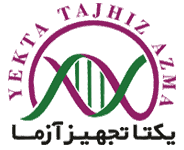How to extract genomic DNA from blood
How to extract genomic DNA from blood
In this article , you learn how to extract genomic DNA from blood using commercial DNA extraction kits based on column method. Applications: This method is used to extract genomic DNA from peripheral blood samples.
The basis of genomic DNA extraction kit:
This technology works first by cell lysis and then by removing proteins using chatropic salt and proteinase K and binding DNA to the silicon substrate, then washing the DNA with ethanol. Finally, the size of purified DNA is up to 50kb (20-30kb). One of the advantages of this method compared to extraction by salt saturation method is the faster time to perform this test.
Genomic DNA can be extracted from whole blood (fresh or frozen), plasma, serum, swabs, body fluids, lymphocytes, and cultured cells.Sample required size : 5-10 ml peripheral blood Type of sample: peripheral blood sample Amount of product: 100-300 microliters of buffy coat, which depends on the type of sample and the number of cells in the sample. Container: Falcon 15ml disposable tubes with K2-EDTA anticoagulant
Unacceptable Criteria for sample in DNA extraction kit :
- The sample is a clot
- Collected in an anticoagulant other than EDTA.
- Volume less than 5 ml
Sample storage:
The peripheral blood sample before extraction can be stored at room temperature for 24 hours, up to 2 weeks at 4֯ C. After the DNA extraction process, the genomic DNA sample can be stored in special 1.5 ml microtube boxes for up to 1 year at a temperature of 4°C and for several years at a temperature of -20°C.
Equipment needed for DNA extraction process :
- Refrigerated microwave
- Refrigerated centrifuge
- Nanodrop
- Variable sampler
- sampler head
- 5 ml microtube
- Ben Marie or block heater
- Vortex
- single-use gloves
- 15 ml Falcon tubes
- Box for storing 5 ml microtubes
Consumables needed for genomic DNA extraction based on column method :
- The contents of the Blood Genomic DNA extraction mini kit should be kept at room temperature 15-25 ͦC.
- RNase A (optional)
- Sterile distilled water
- Ethanol ℅96
Test process for DNA extraction:
The contents of the kit include of :
- BG Buffer (ready to use)
- Wash1 Buffer (before using for the first time, we add 8 ml of 96-100% ethanol to this buffer)
- Wash 2 Buffer (before using for the first time, we add 40 ml of 96-100% ethanol to this buffer)
- Elution Buffer (it is better to aliquot the buffer before consumption)
- 11 mg proteinase to which we add 1.1 ml of sterile ddH2O.
- BG Mini Column
- Collection tube
- Elution tube
- First, we record the characters, code, extraction date, extraction method in the extraction book.
- For the number of samples, take a 5 ml microtube and write the code and character of the sample on the wall and lid of the tubes.
- The sample used is whole blood or buffy coat.
* Preparation of buffy coat:
To prepare Buffy Coat, we centrifuge whole blood at 3000 rpm for 7 minutes or 800g for 20 minutes. The white liquid formed between the layer of red blood cells at the bottom and plasma at the top is buffy coat. To separate the Buffy Coat layer, it is better to remove the serum on the Buffy Coat slowly with a pipette or remove the 1000 Buffy Coat sampler. DNA extracted from buffy coat will have 5-10 times more DNA than whole blood.
- . We transfer 300 µl of the buffy coat to a 5 ml microtube.
Note : If the sample volume is less than 200 µl, we will increase the volume to 200 µl using PBS (HORC-UB-W-22-00) or physiological serum.
- When we use the buffy coat, there is no need to wash it with distilled water, but when it is removed with some blood, it must be washed with distilled water once or twice, depending on the amount of RBC. )
- . If RNase-free Genomic DNA sample is required, add 4 µl of RNase A and incubate for 2 minutes at room temperature, then perform the next step. Otherwise, perform step number 3 immediately.
- Add 20 µl of proteinase K (kept in the refrigerator) and 200 µl of BG buffer to the samples, then vortex completely. We incubate at 60 degrees Celsius until the cells are lysed. During the incubation, we vortex the samples every 10 minutes.
- Spin the samples, then add 200 µl of 96-100% ethanol and vortex completely for 3 seconds. (Vortex is very important at this stage)
- Spin the samples. For each sample, we place a BG column on a collection tube and put the sample on the column and centrifuge it at 8000 rpm for 2 minutes.
- Place the columns on the new collection tubes and add 500 µl W1buffer to the columns and centrifuge at 14000 rpm for 2 minutes. (If the sample is not clear, you can repeat this step, but for 1 minute)
- . Place the columns on the new collection tubes and add 750 µl Wash buffer to the columns and centrifuge at 14000 rpm for 2 minutes. If the sample is not clear, you can repeat this step, but for 1 minute.
- . Centrifuge at 14,000 rpm for 3 minutes to dry the columns.
- . Place the columns on a new microtube and add 100-200 µl of buffer elution or ddH2O (PH: 7.5-9.0) Pouring in the middle of the columns and after 30-60 minutes, centrifuge at 14000 rpm for 2 minutes.
Note: The standard volume of elution buffer is 200 µl, but if there are few cells, the amount of elution buffer can be reduced from 50-150 µl to increase the concentration of DNA.
- Store DNA samples at 4°C or -20°C.
You can also refer to following products: Blood DNA extraction mini kit | Tissue DNA extraction mini kit | Total RNA extraction kit



